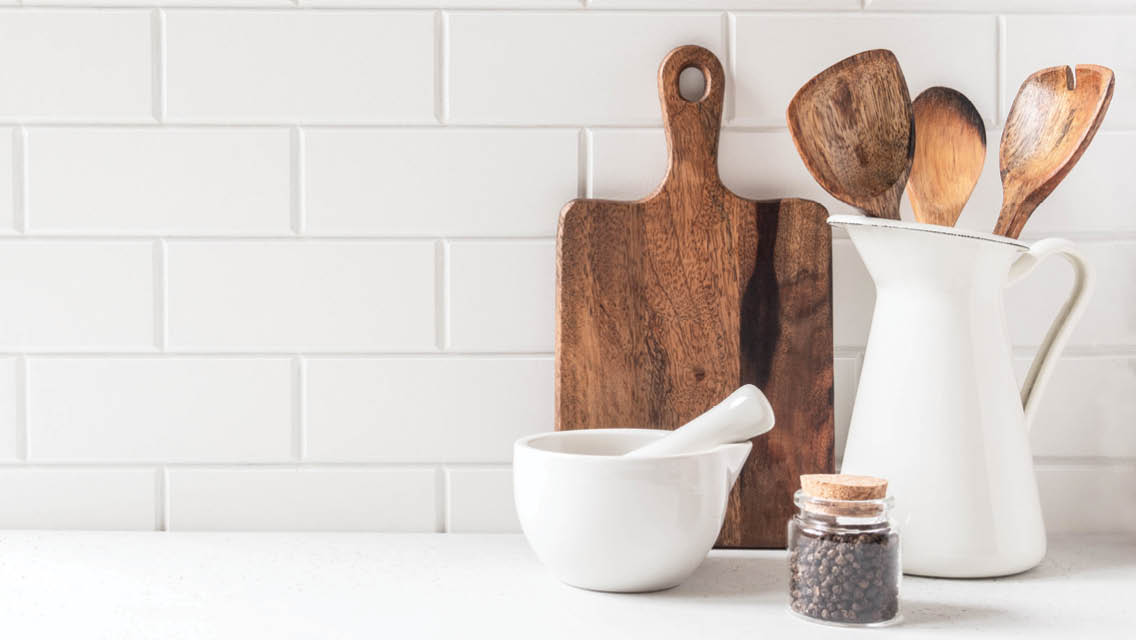We’ve all been there before: opening the fridge to find a browned, wilted cabbage or a dull, shriveled zucchini tucked away in the crisper, days past its prime, destined for the trashcan. In the United States, we throw away more than 200 pounds of food per person annually — about 30 to 40 percent of all food purchased.
There’s no denying we have a profound food-waste problem, but it’s within our power to fix. With minor tweaks to our daily routines, we can each reduce the amount of trash coming out of our own kitchens, shrink our carbon footprints, and lower the burden on our landfills.
These ideas will start you on your way to a more eco-friendly kitchen.
1. Plan Ahead
One of the simplest and most effective ways to curb food waste is to buy only what you need. Plan meals in advance, write a grocery list and stick to it, and take special care to avoid overbuying perishable items. Planning ahead also allows you to flex your culinary skills and take advantage of what’s local and in season. (Find more meal-planning tips at “How to Simplify Meal Planning“.)
“I like to draw inspiration from restaurant menus or the prepared-food counter of the health-food store,” writes environmental activist Bea Johnson in Zero Waste Home. “This approach feeds my creativity and fits my shopping style of buying seasonally.”
2. Get Organized
Be aware of expiration dates and arrange your pantry and fridge so you’ll reach first for the items that are set to go out of date soonest. No one wants to discover a carton of yogurt that’s sprouting mold in the back of the fridge.
Before grocery shopping, review the contents of your pantry and fridge. This will help prevent you from accidentally doubling (or tripling) up on products you already have on hand.
3. Save Your Scraps
Rather than relegating them to the trash, save kale stems, carrot tops, onion peels, and other scraps for making stocks and soups. As Lindsay-Jean Hard notes in her book, Cooking With Scraps, “[It] shouldn’t be intimidating or overwhelming or feel like a chore: They’re just ingredients.”
With that in mind, use your apple cores and peels to make vinegar; candy those citrus rinds; and turn your stale bread into croutons. (Find five of Hard’s food-scrap recipes at “5 Root-to-Stem Recipes“.)
4. Wait to Wash Produce
Wash your veggies and fruits only when you’re about to use them instead of running them under the tap as soon as you unpack them at home. Washing produce before storing it causes some items to spoil more quickly. (See “From Harvest to Home: A Guide to Handling Produce” for more tips on improving the shelf life of your fresh produce.)
5. Freeze It
Meal-prep fans already know how indispensable the freezer is for long-term storage — and on the journey to reduce your food waste, it’s your closest ally. Stash a pint of mushy berries there to add to smoothies, bake into a cobbler, or turn into a jam. Freeze overripe bananas for banana bread or use frozen beets for pickling.
Even fresh herbs can be frozen and saved for later: Chop them up and pop them into ice trays with a bit of organic extra-virgin olive oil. When you’re ready to use the herbs, just add a cube directly to a hot skillet. (Try these 20 tips and tricks to save even more time, money, and resources.)
6. Be Flexible
If you’re making a recipe that calls for onions but have only leeks on hand, make the swap. Recipes are just guidelines, and cooking is an organic process. Improvise as you cook, and don’t feel like you absolutely must follow a recipe to the letter.
Use the ingredients you have on hand — you might be surprised by how delicious your dish turns out. (Find a few of our favorite flexible dishes — plus tips for stocking a pantry that will make it easy to improvise — at “How to Stock a Basic Food Pantry“.)
7. Share the Wealth
Made too much veggie stir-fry or chicken curry? If you find yourself laden with leftovers, you can always freeze them — or better yet, offer some to your neighbors. It’s not only a way to reduce your food waste; it’s a great way to foster community.
8. Skip the Plastic . . .
It’s difficult and expensive to recycle plastic, so even if you put that empty almond-butter jar in your recycling bin, it’s likely to end up in a landfill instead. That’s why it’s important to purchase plastic-free products at the grocery store whenever possible.
If you find items you regularly buy in those pesky plastics — containers of rice, for example — consider buying from bulk bins. It’s a stellar option for dried spices and herbs, because you can create spice blends at home rather than buying tons of individual bottles. (Get more tips for living with less plastic at “18 Ways to Live With Less Plastic“.)
9. . . . Or Reuse It
Some plastics are unavoidable. Instead of throwing out those empty takeout containers, as long as they’re marked with number 2, 4, or 5, you can reuse them. They’re great for storing leftovers, homemade condiments, and make-ahead meals. You can also wash and reuse plastic bags — just don’t put plastic in the dishwasher or microwave.
10. Say No to Single-Use Products
To move away from plastic wrap and bags entirely, invest in beeswax paper. This clever reusable alternative has antimicrobial properties, so it not only is more sustainable but also may help limit food spoilage. You can also buy silicone sandwich bags, which can be washed and reused.
Coffee drinkers might consider switching to reusable coffee filters (and don’t forget, those coffee grounds can be used as fertilizer for your acid-loving plants). If you’re a tea drinker, opt for loose-leaf tea or buy only brands that use biodegradable teabags.
As for paper towels? Trade paper for cloth towels and use them whenever possible. “If you stop buying single-use products for your kitchen,” Johnson writes, “you will quickly realize that living without them is quite possible.”
11. Make It Yourself
We all fall victim to convenience. How simple is it to add a bottle of ketchup or jar of mayonnaise to your shopping cart? Instead, consider making them at home. You’ll be buying fewer plastics, and the condiments you create will be completely preservative-free. You can also make Greek-style yogurt, granola, and hummus at home with relative ease. (Find some of our favorite scratch-made recipes at “5 Made From Scratch Recipes“.)
12. Compost It
“Even after using every possible part of your food and storing it properly, you’re still going to have some food waste,” writes Hard. “Those scraps don’t need to be sent to a landfill; they can be composted to return valuable nutrients to the soil.”
Those apple cores, veggie peels, and tea leaves can all be used to nourish the soil in your garden. Mix coffee grounds into the soils planted with roses, blueberries, lilies, cabbage, and hydrangeas.
Don’t have a garden? Collect scraps in a bin and use curbside compost, if available, or reach out to your local community garden to see if they accept compost. (Get our tips for beginner composting at “How to Start Composting“.)
This article originally appeared as “Your Eco-Friendly Kitchen” in the April 2022 issue of Experience Life.





This Post Has 0 Comments